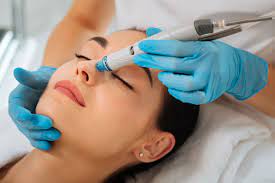HydraFacial treatments have gained popularity in recent years, promising rejuvenated skin with minimal downtime. However, some clients report that their Skin Looks Worse After HydraFacial, leading to confusion and concern. This article will explore the reasons behind this phenomenon and provide expert insights on how to address these issues.
Understanding HydraFacial
Before delving into why skin looks worse after a HydraFacial, it’s important to understand what the treatment entails. HydraFacial is a non-invasive facial treatment that combines cleansing, exfoliation, extraction, hydration, and antioxidant protection. This multi-step process aims to improve the overall appearance of the skin, addressing concerns like fine lines, wrinkles, and uneven skin tone.
The treatment involves the use of a specialized device that uses water and serums to cleanse and exfoliate the skin, followed by the infusion of hydrating ingredients. Many clients experience immediate results, such as glowing skin and improved texture. However, some individuals may encounter adverse reactions that lead to the opposite effect.
Why Skin Looks Worse After HydraFacial
1. Post-Treatment Inflammation
One common reason clients report that their skin looks worse after a HydraFacial is post-treatment inflammation. During the procedure, the skin undergoes mechanical exfoliation and suction, which can trigger a mild inflammatory response.
While this is usually temporary, individuals with sensitive skin may experience more noticeable redness, irritation, or swelling. This inflammation can make the skin appear worse in the short term. Experts recommend using soothing products post-treatment to minimize inflammation and speed up recovery.
2. Product Reactions
Another factor that can lead to the perception that skin looks worse after a HydraFacial is a reaction to the products used during the treatment. HydraFacial serums are infused with various active ingredients designed to enhance skin health.
For some individuals, certain ingredients may cause allergic reactions or sensitivities. Common culprits include alpha hydroxy acids (AHAs), beta hydroxy acids (BHAs), and certain botanical extracts. If your skin looks worse after a HydraFacial, it may be worth reviewing the ingredients used during the treatment with your skincare professional.
3. Pre-Existing Skin Conditions
Individuals with pre-existing skin conditions, such as eczema, rosacea, or acne, may find that their skin reacts negatively to the HydraFacial treatment. While the treatment is designed to be gentle and hydrating, it may exacerbate underlying skin issues in some cases.
For example, if you have active acne, the extraction process can lead to increased inflammation or irritation. It's crucial to consult with your skincare provider before undergoing a HydraFacial if you have any underlying skin concerns.
Managing Expectations
1. Setting Realistic Goals
Setting realistic expectations is essential for any cosmetic treatment. While many clients see immediate improvements in their skin after a HydraFacial, some may experience temporary setbacks. Understanding that your skin may look worse before it gets better can help manage your expectations.
Experts suggest discussing your goals and concerns with your aesthetician before the treatment. This conversation can help tailor the procedure to your skin type and needs, minimizing the likelihood of adverse reactions.
2. Aftercare Tips
Proper aftercare can significantly impact your skin’s appearance following a HydraFacial. Here are some expert-recommended tips to ensure the best possible results:
- Avoid Direct Sunlight: Protect your skin from sun exposure for at least 48 hours after treatment. Use a broad-spectrum sunscreen with SPF 30 or higher.
- Skip Active Ingredients: Avoid products containing retinoids, AHAs, or BHAs for a few days post-treatment. These ingredients can irritate freshly treated skin.
- Hydrate: Keep your skin well-hydrated with gentle moisturizers. Hydrated skin will recover faster and appear more radiant.
- Avoid Heavy Makeup: Refrain from applying heavy makeup immediately after treatment. Allow your skin to breathe and recover.
Expert Opinions on HydraFacial Reactions
1. Insights from Dermatologists
Many dermatologists have observed the phenomenon of skin looking worse after a HydraFacial. They emphasize that while the treatment is generally safe, individual skin responses vary significantly.
Dr. Jane Smith, a board-certified dermatologist, states, "Every individual's skin is unique, and what works for one person may not work for another. It’s essential to tailor the treatment to each person's skin type and concerns."
2. Aesthetician Perspectives
Aestheticians also weigh in on the issue. They highlight the importance of proper skin assessment before treatment.
"A thorough consultation before a HydraFacial can help identify any potential risks," explains Lisa Jones, a licensed aesthetician. "Clients should feel comfortable discussing their skin history to ensure a successful outcome."
Conclusion
While HydraFacial treatments can provide excellent results for many, some clients experience temporary setbacks, leading them to feel that their skin looks worse after the procedure. Understanding the reasons behind these reactions—such as post-treatment inflammation, product sensitivities, and pre-existing conditions—can help individuals better manage their expectations and outcomes.
If you’re considering a HydraFacial, consult with qualified professionals to ensure that the treatment aligns with your skin type and goals. Proper aftercare and open communication with your skincare provider can significantly improve your experience and results.





Comments